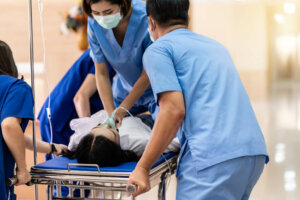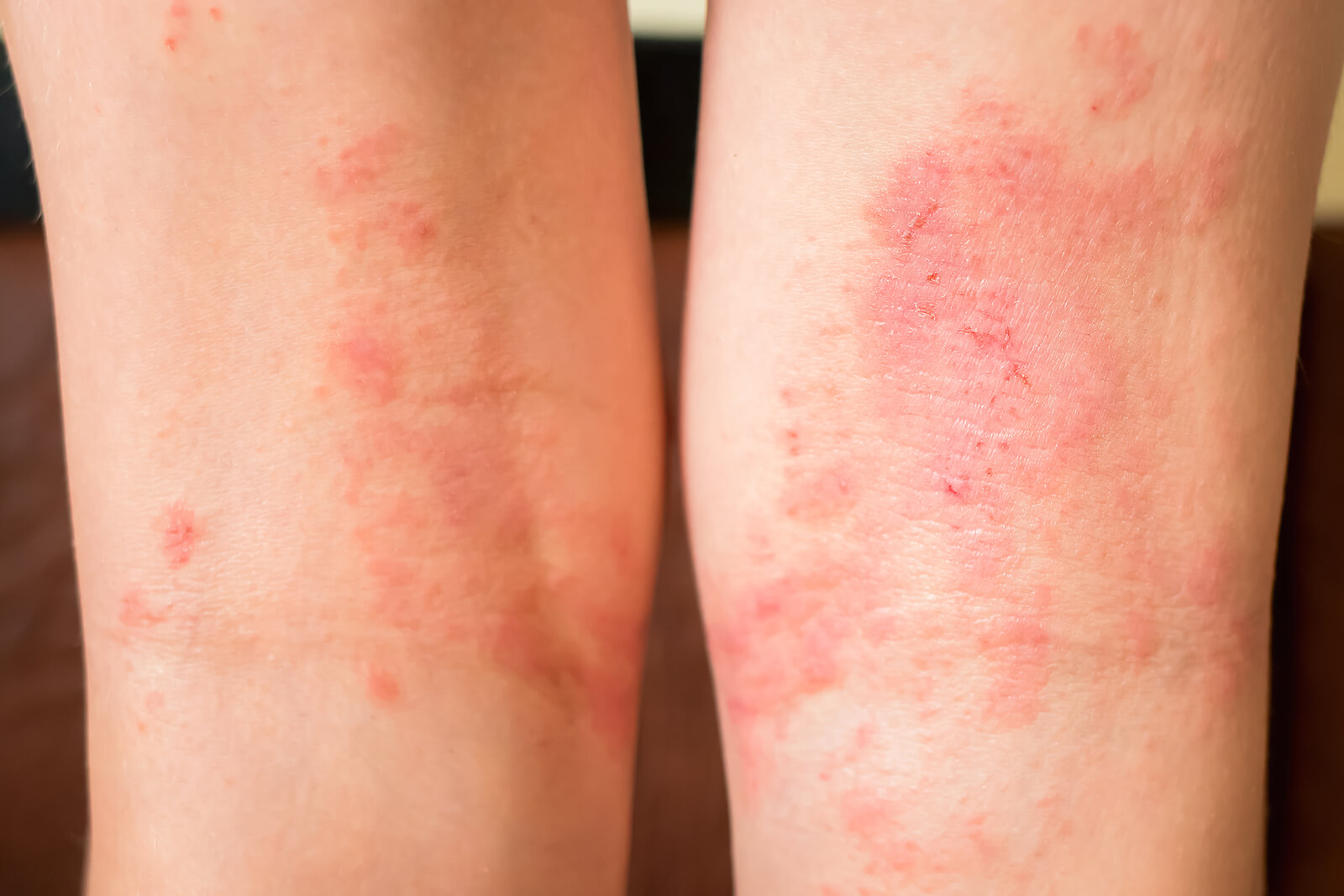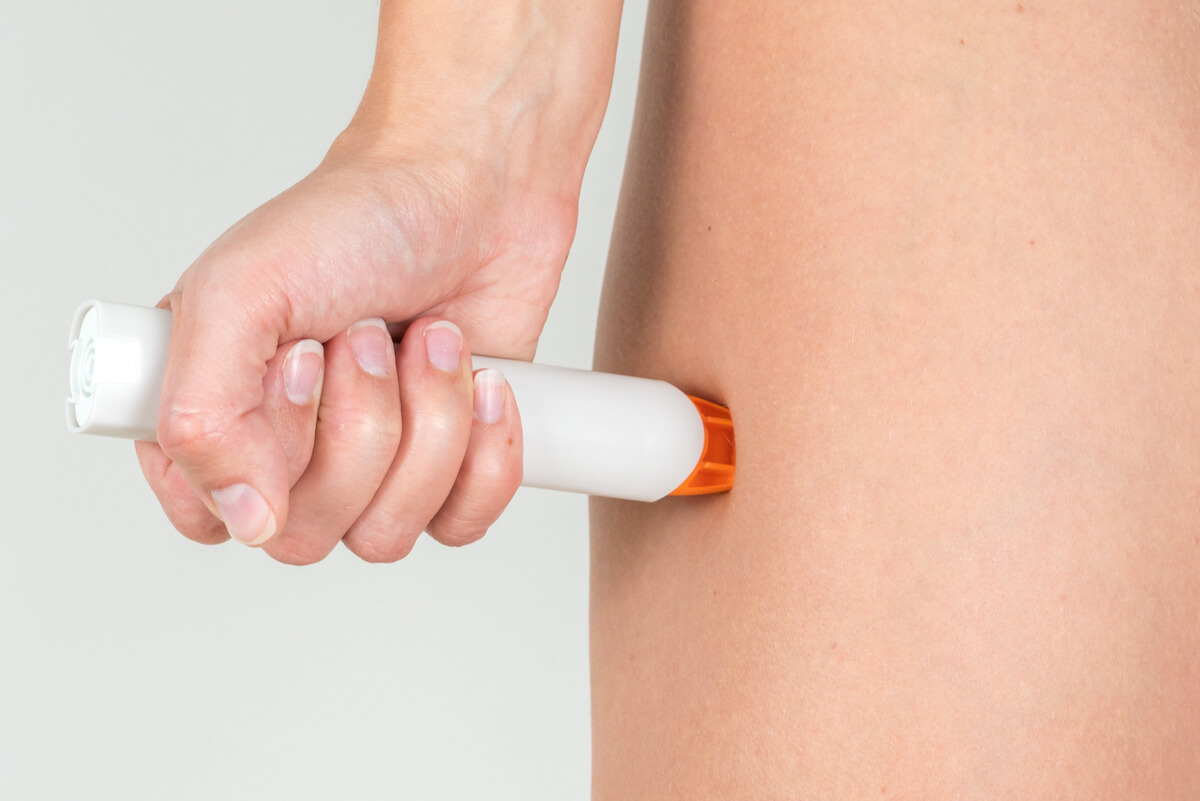Treatment of Anaphylaxis

Anaphylaxis is a term that’s used to group together the set of sudden and serious allergic reactions, which can be caused by foods such as different types of nuts, certain medication, and insect stings (such as the Germanic wasp or the red ant). Find out about the correct treatment of anaphylaxis
The worrying aspect here is that they can be fatal if not treated in time. Because of this, treatment for anaphylaxis simply mustn’t be delayed. The sooner it’s administered, the better the prognosis may be for the affected person.
In addition to the concern that its sudden onset and rapid evolution can cause, another worrying thing about anaphylaxis is the way it can affect several different parts of the body (from the immune system to the cardiovascular system). This happens almost simultaneously, and, once again, if left untreated, it can lead to respiratory collapse.
Some questions come to mind. What does the treatment of anaphylaxis include? What can you do while you await medical help? Is any other action necessary after I’ve been discharged from hospital? These are some of the most common questions people have, and we’ll try to answer them below.
First aid and emergency care

Anaphylaxis can occur shortly after exposure to the allergen as well as some time after (which can be 4-8 hours later).
However, regardless of this, when the person begins to show symptoms (swelling, itching, hives, restlessness, problems breathing and speaking, weak pulse, dizziness, red eyes, etc.) it’s essential to seek medical attention.
While paramedics arrive, it’s advisable to provide first aid to the person. According to Mayo Clinic experts, this may include the following:
- If the person is wearing tight-fitting garments, help them remove or loosen them.
- Don’t offer them anything to eat or drink.
- If you know how to, try to keep track of the affected person’s pulse.
- If they vomit or if blood comes out of their mouth, turn them on their side. This will help prevent choking.
- Don’t administer any commonly used antihistamine, unless the person already has a prescription that approves its use in case of anaphylaxis. If so, all the indications given by the treating doctor must be followed.
- Even if you give the person an antihistamine, it won’t be enough to treat anaphylaxis. Therefore, medical help should still be sought.
- Ask the person if they carry an epinephrine (adrenaline) auto-injector. Help them to lie on their back, and inject it into their thigh, pressing in as you do so.
- If the person has passed out and isn’t breathing, begin cardiopulmonary resuscitation (CPR) until paramedics arrive.
- If the person hasn’t passed out, it’s important to help them to keep as calm as possible until help arrives. One good option is to lie them on their back and raise their legs.
Never wait for the symptoms of anaphylaxis to resolve on their own. A lack of immediate medical assistance can lead to death in about half an hour.
Treatment options

Once a person has been transferred to the hospital, as outlined in the MSD Manual, treatment for anaphylaxis may include the following:
- Epinephrine (adrenaline) injected under the skin, intramuscularly, or sometimes intravenously or intraosseously.
- Generally, the intravenous option is chosen when the person has excessively low blood pressure.
- Epinephrine helps relax the muscles in the airways and narrow the blood vessels.
- Antihistamines (such as diphenhydramine) and histamine (H2) blockers (such as cimetidine) administered intravenously until symptoms disappear.
- Vasoconstrictor drugs (to increase blood pressure)
- Inhaled beta-agonists (such as salbutamol) to dilate the airways, reduce wheezing, and make breathing easier.
- An oropharyngeal tube and face mask ventilation balloon to give oxygen (this is performed when the person has great difficulty breathing).
- Serum administered intravenously.
Once the anaphylaxis treatment has been administered, the patient will be taken to a recovery room, where their progress can be observed for the next several hours. This is because, in some cases, the symptoms of anaphylaxis recur.
What to expect after discharge?
After discharge, the doctor may suggest that the person wears a bracelet or some other similar accessory to indicate the allergies they suffer from. They’ll also probably explain to you that you need to carry an epinephrine auto-injectable syringe with you so that you can resort to it if necessary, while you wait for help from the paramedics.
From now on, the best treatment for anaphylaxis will be to avoid what could trigger the condition (insect bites, and certain food and medicine, etc.).
It’s important to note that you don’t need to make drastic lifestyle changes in order to avoid anaphylaxis (unless directed by your doctor). Generally, the above-mentioned suffices.
Anaphylaxis is a term that’s used to group together the set of sudden and serious allergic reactions, which can be caused by foods such as different types of nuts, certain medication, and insect stings (such as the Germanic wasp or the red ant). Find out about the correct treatment of anaphylaxis
The worrying aspect here is that they can be fatal if not treated in time. Because of this, treatment for anaphylaxis simply mustn’t be delayed. The sooner it’s administered, the better the prognosis may be for the affected person.
In addition to the concern that its sudden onset and rapid evolution can cause, another worrying thing about anaphylaxis is the way it can affect several different parts of the body (from the immune system to the cardiovascular system). This happens almost simultaneously, and, once again, if left untreated, it can lead to respiratory collapse.
Some questions come to mind. What does the treatment of anaphylaxis include? What can you do while you await medical help? Is any other action necessary after I’ve been discharged from hospital? These are some of the most common questions people have, and we’ll try to answer them below.
First aid and emergency care

Anaphylaxis can occur shortly after exposure to the allergen as well as some time after (which can be 4-8 hours later).
However, regardless of this, when the person begins to show symptoms (swelling, itching, hives, restlessness, problems breathing and speaking, weak pulse, dizziness, red eyes, etc.) it’s essential to seek medical attention.
While paramedics arrive, it’s advisable to provide first aid to the person. According to Mayo Clinic experts, this may include the following:
- If the person is wearing tight-fitting garments, help them remove or loosen them.
- Don’t offer them anything to eat or drink.
- If you know how to, try to keep track of the affected person’s pulse.
- If they vomit or if blood comes out of their mouth, turn them on their side. This will help prevent choking.
- Don’t administer any commonly used antihistamine, unless the person already has a prescription that approves its use in case of anaphylaxis. If so, all the indications given by the treating doctor must be followed.
- Even if you give the person an antihistamine, it won’t be enough to treat anaphylaxis. Therefore, medical help should still be sought.
- Ask the person if they carry an epinephrine (adrenaline) auto-injector. Help them to lie on their back, and inject it into their thigh, pressing in as you do so.
- If the person has passed out and isn’t breathing, begin cardiopulmonary resuscitation (CPR) until paramedics arrive.
- If the person hasn’t passed out, it’s important to help them to keep as calm as possible until help arrives. One good option is to lie them on their back and raise their legs.
Never wait for the symptoms of anaphylaxis to resolve on their own. A lack of immediate medical assistance can lead to death in about half an hour.
Treatment options

Once a person has been transferred to the hospital, as outlined in the MSD Manual, treatment for anaphylaxis may include the following:
- Epinephrine (adrenaline) injected under the skin, intramuscularly, or sometimes intravenously or intraosseously.
- Generally, the intravenous option is chosen when the person has excessively low blood pressure.
- Epinephrine helps relax the muscles in the airways and narrow the blood vessels.
- Antihistamines (such as diphenhydramine) and histamine (H2) blockers (such as cimetidine) administered intravenously until symptoms disappear.
- Vasoconstrictor drugs (to increase blood pressure)
- Inhaled beta-agonists (such as salbutamol) to dilate the airways, reduce wheezing, and make breathing easier.
- An oropharyngeal tube and face mask ventilation balloon to give oxygen (this is performed when the person has great difficulty breathing).
- Serum administered intravenously.
Once the anaphylaxis treatment has been administered, the patient will be taken to a recovery room, where their progress can be observed for the next several hours. This is because, in some cases, the symptoms of anaphylaxis recur.
What to expect after discharge?
After discharge, the doctor may suggest that the person wears a bracelet or some other similar accessory to indicate the allergies they suffer from. They’ll also probably explain to you that you need to carry an epinephrine auto-injectable syringe with you so that you can resort to it if necessary, while you wait for help from the paramedics.
From now on, the best treatment for anaphylaxis will be to avoid what could trigger the condition (insect bites, and certain food and medicine, etc.).
It’s important to note that you don’t need to make drastic lifestyle changes in order to avoid anaphylaxis (unless directed by your doctor). Generally, the above-mentioned suffices.
-
“Datos Clave: Reacciones Anafilácticas .” n.d. Manual Merck Versión Para El Público General. Accessed June 15, 2021. https://www.merckmanuals.com/es-pr/hogar/breve-información-trastornos-inmunológicos/reacciones-alérgicas-y-otros-trastornos-de-hipersensibilidad/reacciones-anafilácticas.
-
Delves, Peter J. 2020. “Anafilaxia – Inmunología y Trastornos Alérgicos.” In Manual MSD Versión Para Profesionales. https://www.msdmanuals.com/es/professional/inmunología-y-trastornos-alérgicos/enfermedades-alérgicas,-autoinmunitarias-y-otros-trastornos-por-hipersensibilidad/anafilaxia.
-
Gómez Ayala, Adela-Emilia. 2011. “Anafilaxia. Clínica y Tratamiento.” Offarm 30 (2): 70–78. https://www.elsevier.es/es-revista-offarm-4-articulo-anafilaxia-clinica-tratamiento-X0212047X11011351.
- Sienra-Monge JJL, Navarrete-Rodríguez EM, Chávez-Flores U, Lezana-Fernández MA, Baeza-Bastarrachea RA, Baeza-Bacab MA et al. Anafilaxia en niños y adultos: prevención, diagnóstico y tratamiento. Rev CONAMED 2019; 24(3): 107-164
Este texto se ofrece únicamente con propósitos informativos y no reemplaza la consulta con un profesional. Ante dudas, consulta a tu especialista.







